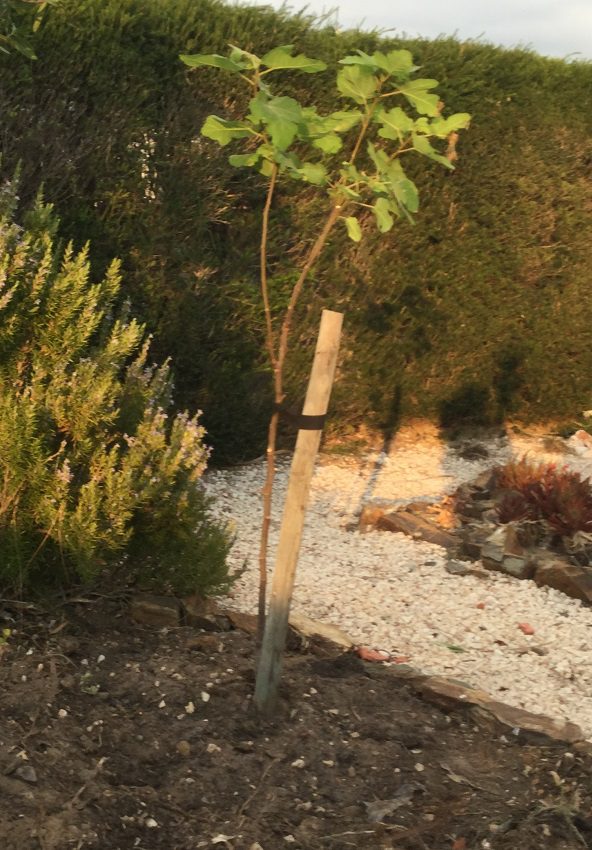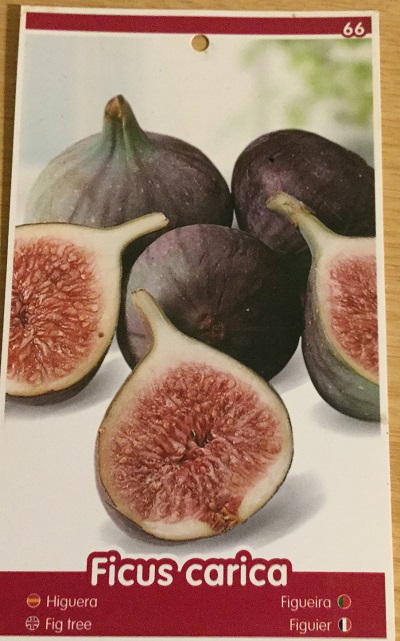I finally succumbed and purchased yet another fig tree. I’ve now killed five so hope this one has a little more luck than its predecessors! I am obviously doing something wrong as they grow in the wild without any care or attention. They also seem unperturbed by the salt winds as several neighbours have mature trees .We will see.

This time around I bought my fig tree from a specialist nursery and one of the staff confidently assured me that less than 10 in 200 trees die. Considering I’ve had five fatalities surely the odds are stacked in my favour and this one will survive.
To give my fig tree a fighting chance I bought manure based organic fertiliser (SIRO AGRO 2) to mix with our thin sandy soil.

Location: It’s planted in full sun and as our winter temperatures rarely drop below freezing temperature is not an issue.
Watering: I was previously informed that the greatest threat to a fig tree is over watering . However, it seems this was not sound advice and probably why my earlier trees died. But how much water does a young tree need? After extensive research I came across two interesting articles: How Not To Kill Your Fig Tree and ‘How to Water a Fig Tree
Apparently the roots do not grow down to seek water they spread out and stay near the surface. I wish I’d discovered this sooner because we dug a hole deep enough to bury a body.
However, Gardening Know How claims: Fig trees have a deep, aggressive root system.
Now I’m confused.
In hot weather it is imperative that the tree is well watered otherwise the leaves will yellow and fall. Drooping leaves in the late afternoon is a sure sign the tree needs watering.
Hunker.com recommends young trees need about 10 gallons of water three times a week for the first year. Wow! that’s about 100 liters of water per week. This seems an awful lot of water for a small tree. Gardening KnowHow states the tree needs about 1-1 1/2 inches of water per week. That’s nowhere near as much.
Again, I’m confused and will work on the droopy leaf theory.
Another tip is to mulch around the tree to aid water retention.
Pruning: As fruit grows on the new growth I should not be tempted to prune back hard in the winter.If pruning is required prune immediately after cropping.
Pictorial instructions on how to prune a fig tree is available at Wiki How
Fruit: Leave fruit on the trees to ripen.
Reference:
How to Care for a Fig Tree This includes some great advice for growing fig trees in pots. I never realized you had to trim the roots every 3-5 years!
hunker.com
www.tropicamango.com

I wonder what it will look like this time next year?
Can anyone shed any further light on the watering situation, please?
Bloggers, if you would like to meet other gardening bloggers use the hashtag #getgardening and add a comment with a link to your post on my gardening page


Humm. I have had no problems growing fig trees, here in England, so they should be able to tollerate being watered. I don’t need to water my tree here. Even during droughty hot summers. I rarely get to eat many of my figs, as the wasps get them first!
LikeLike
I don’t what it is with me and fig trees. They grow quite happily in the wild … maybe I kill mine with love.
LikeLike
Wow, Jo. You must be VERY excited. Which part of the Algarve are you moving to?
LikeLike
I shall be coming back to you for tips. Always wanted a fig tree. 🙂 🙂 We move out there this weekend!
LikeLiked by 1 person
Great post. When we move back to the UK we want to have a fig tree so this is very helpful.
LikeLiked by 1 person
One of the links I shared for reference spoke of keeping figs in the UK. Seems like you need a sunny wall in sheltered position. min temp of up to around -8. Our relatives in France and the UK both grow them and they ahve been successful
LikeLiked by 1 person
Our back garden should do the trick. Ticks all the boxes.
LikeLiked by 1 person
Good luck with the new fig tree. When we bought our house it already came with a fig tree in the front garden. It low and wide and we never water it, so the only water it gets is from the rain, which is usually not abundant in Perth.
It has fruited and very well every year. (We removed grass from our front garden and changed plants to mainly succulents and native plants so we wouldn’t have to water).
LikeLiked by 1 person
I am envious 🙂 I wonder how many years it will take to fruit.
LikeLike
Hi Angie, was it the writing group in Tavira or the one in the Lagoa? Are you still writing? I think I can picture you. You also went to Ann’s writing course a few years back?
As for my fig tree, I’ve not planted near the fossa. I was tempted as it is the perfect location, but I remembered someone mentioned how invasive the roots were.
LikeLike
Piglet..take care. If it does well the roots will head towards a cistern or pool if you have one. Our neighbour has massive problem this week with whole root system in her cistern. They are very strong and invasive and roots travel long distances. …. Angie xx (we met at writing group 2 years ago!)
LikeLiked by 2 people
You BOUGHT a fig tree?! Oh my! I grew all 14 of mine from twigs stuck in the ground. (They are stock trees that provide cuttings, so they are not all making fruit at the same time! That would be a serious mess!) Root suckers from the base of the trunk of a mature tree can be pulled off with a few roots attached while dormant in winter. Even if no roots come with it, just getting a bit of the callus (where the roots formed) is good enough. Those suckers root even more easily than cuttings. This should be done while trees are bare in winter. I like to do it earlier in winter than later; as soon as the leaves fall off. I think that if you pay more attention what the tree tells you than what you read online, the tree will be happier. Figs do develop on new stems, but also on old stems. Yes, really. Fig trees have two crops. However, some varieties produce a better early crop, and others produce a better late crop. For some, the early crop is best for eating fresh, and cooking with, while the second crop is better for drying. Every cultivar has its own personality. Anyway, if you prefer the first crop that develops on old stems, you should prune as minimally as possible (without letting the tree get too big and sloppy). If you prefer the second crop that develops on new stems, you can prune more aggressively. It takes a few years to determine how much pruning you want to do, and once you do, it changes because the tree is always growing, and bigger trees need more pruning. Wow, I am sorry to leave such a long message.
LikeLiked by 1 person
Hi Tony,
Thank you for sharing so many tips!
I’ll ask around and see if anyone has a more established fig tree they would be prepared to let me have a sucker. I’d like to try your idea. I was going to buy another tree, much smaller and compact and grow in a pot as I only have space for one tree.
I better get out there now and mulch the tree. Think I will need to use some breathable membrane for now as I get get out to the shops. the weather has just turned again and we are in for a hot spell.
LikeLiked by 1 person
Fig trees are too big for pots. They like to disperse their roots more than pots will allow. However, some people get good fruit from small potted trees! Just be aware that they are sneaky about rooting out the drainage holes, and can easily break their pots as their roots expand. It will also be very important to prune them aggressively to keep them confined. Otherwise, they will get bigger than their confined roots can sustain.
LikeLike
Hi Tony, i was surprised to discover they could be grown in pots but was dependent on you removing the plant from the plant every 3 years and trimming the leader and other roots.. We will see. 🙂
LikeLiked by 1 person
Just because the ‘can’ be grown in pots does not mean that they ‘should’. Figs actually are grown as bonsai, which live in bonsai dishes for a very long time. I know one that might be a century old now. However, bonsai trees are very different from trees that are expected to produce fruit. Some of my small trees fruited while still canned, and some even made rather good fruit. However, there were only a few, and the fruit can easily be ruined if the watering fluctuated during the time that the fruit is developing.
LikeLiked by 1 person
The nice thing about growing figs from root suckers that need to be removed from the parent tree anyway, is that they are expendable. You can grow as many as you like. They do not cost anything. If you try them in pots and do not like the results, it would be not big loss. Besides, even if they do not do well in pots, they will not likely die. you cold plant a distressed tree in the ground, and it would probably recover.
LikeLiked by 1 person
Definitely mulch !! Properly – but keep away from the trunk of the tree !! As soon as planted ! If you are not good with a finger reconnaissance test just buy a cheap moisture meter and look at it every day. And personally I would have bought a smaller tree to begin with . . . .you should not have lost even one . . oh, and do NOT plant a tree where one has died: you may have adverse chemicals in that spot in the soil . . .
LikeLiked by 1 person
Oh, Just noticed the manure: I do hope you prepared your poor soil at least a few weeks in advance, not when you planted the fig: a fresh soil mix would be a certain death to the new tree
LikeLiked by 1 person
Hey, Eh. I’ve bought smaller trees in the past and it made no difference. This tree is about five foot tall. As for ‘finger recon’ *laughing* I’ve done that in the past and to my horror found a lot of nasties such has scorpions and weird bugs lurking in the sandy soil… I bought a water meter. 🙂
Fortunately, I have planted in a different place. SO fingers firmly crossed.
The fertilizer is meant to be ready to use. I hope so 😦 Ho hum… I hope I’ve not sent another tree to the tree heaven in the sky.
LikeLike